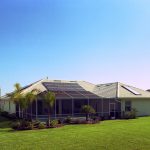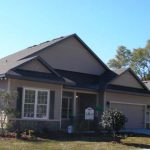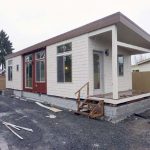
High-performance new homes achieve very low energy use while safe-guarding occupant health and safety, enhancing building durability, and improving occupant comfort in comparison to minimum code-compliant homes.
For full details and economic analysis, see Approaches to 30% Energy Savings at the Community Scale in the Hot-Humid Climate.
High-performance housing brings together high efficiency equipment such as ENERGY STAR®-certified:
- heating, cooling, and water heating equipment,
- cooking and laundry appliances, and
- lighting and fans
with high-performance building components to reduce the need for heating and/or cooling such as:
- ENERGY STAR®-certified windows
- window shading strategies
- climate-appropriate insulation levels and details
- white or light-colored roofing and exterior wall color
and high attention to detail including designing, constructing, and protecting elements that control the movement of air and heat into and out of the house including:
- a continuous thermal barrier in contact with a continuous air barrier,
- a substantially leak-free air distribution system
- an outside air ventilation delivery system, if applicable,
and the management of water, in all its forms, to enhance long term durability by planning for control of:
- ground water using capillary breaks
- surface water using site drainage design,
- rain, snow, and wind-driven rain using primary and secondary drainage planes,
- moisture from cooking, bathing, and laundry activities using spot ventilation and air mixing strategies, and
- moisture moving through building assemblies into or out of the house with infiltration air using a continuous air barrier.
Important phases of high-performance new homes construction process
- Integrated Design Process — This is the first step in the process, and a time to establish goals, select materials and products, and develop construction details. This involves gathering input from all stakeholders including contractors, sub-contractors, building code officials, and product manufacturers. All contractors must be aware of and respect the overall project goals and the role they play in achieving them. Scopes of work that specify what will and will not be done are crucial to reaching the ultimate goals. This phase includes energy-use simulations to compare the cost/benefit of efficiency measures being considered.
- Construction Process — In addition to the normal workflow, general contractor staff, a home energy rater, and/or another third party provides voluntary inspections at critical junctures. This serves as quality control over all contractors and identifies where specifications have not been met. Sub-contract pay is tied to meeting specifications.
- Commissioning — When the house is nearly complete, certain airflow controls need to be set so that they are achieving the desired effects.
- Certifications — Programs like ENERGY STAR® for Homes, LEED for Homes, and the Zero Energy Ready Home program involve submission of forms and checklists. Upon submission and approval, certificates are issued that can be given to buyers as proof that the home meets program metrics.
Zero Energy Homes
 Zero Energy Homes (ZEH) are homes designed to use zero net energy from the utility grid. The concept is simple—couple the maximum possible building energy efficiency with the best-available renewable energy resources so as to achieve zero energy. Learn More: Zero Energy Homes
Zero Energy Homes (ZEH) are homes designed to use zero net energy from the utility grid. The concept is simple—couple the maximum possible building energy efficiency with the best-available renewable energy resources so as to achieve zero energy. Learn More: Zero Energy Homes
Habitat for Humanity Partnership
FSEC’s Habitat for Humanity partnership—formed in 1995 at Habitat’s Environmental Initiative Kickoff—has brought technical assistance into the design, construction, and evaluation process of over 500 Habitat homes across the nation, built by dozens of Habitat for Humanity affiliates in more than 20 states. Learn More: Habitat for Humanity Partnership
Case Studies
 Business Case for High-Performance Homes: Tommy Williams Homes
Business Case for High-Performance Homes: Tommy Williams Homes
Building America research has shown that high-performance homes can potentially give builders an edge in the marketplace. Tommy Williams Homes capitalizes on that edge. Since becoming a Building America partner in 2004, they sold over 250 high-performance homes. Learn More: Case Study
 Technology Solutions for New Manufactured Homes
Technology Solutions for New Manufactured Homes
FSEC worked with manufacturers to prototype and assess the performance of a package of readily available, cost-effective high performance building assemblies and mechanical systems that are not commonly deployed in the manufactured home sector. The measure package, given the working title “High Performance Manufactured Home” (HPMH), is able to reduce energy used for space conditioning, water heating and lighting by 50 percent over typical manufactured homes produced in the Northwest. Learn More: Case Study
Suggested Publications
- Maximum Energy Efficiency Cost Effectiveness in New Home Construction
- Approaches to 30% Energy Savings at the Community Scale in the Hot-Humid Climate
- Measure Guideline: Managing the Drivers of Airflow and Water Vapor Transport in Existing Single-Family Homes
- Comprehensive Modeling of Optimal Paths to Reach Nearly Zero Energy Buildings (nZEBs) for New Constructions in Europe
New Home Certification Programs

Builders who participate in home certification programs have experience coordinating the multitude of details necessary for achieving high performance goals related to energy efficiency, indoor air quality, building durability, and occupant comfort. Each certification program is based on a rigorous standard of construction, and sets forth mandatory requirements, yet includes enough flexibility to allow for a wide range of design and construction methods.
Learn More: New Home Certification Programs
